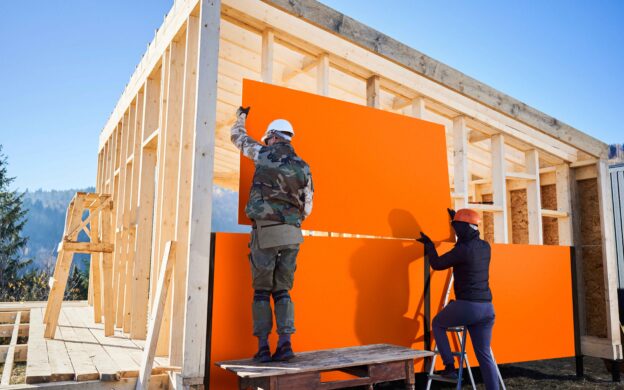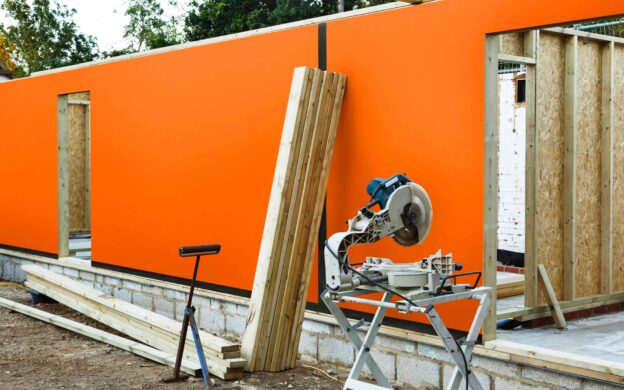
If new talent cannot easily be attracted to a career in construction, then the discussion could turn to the provocative idea of ‘deskilling’. Is the answer to find alternative ways to deliver buildings that don’t rely so heavily on skilled workers?
The government and the timber industry don’t seem to think so, as they are setting out plans to grow the UK timber industry, including constructing more buildings from home-grown timber using modern methods of construction. The roadmap includes ideas for attracting new talent to the sector, as well as training and developing those already working in it.
While we wait for those plans to be further developed and realised, what innovations in timber framed housing are helping to reduce the demand on site labour?
What is the extent of the UK construction industry’s skills shortage?
The construction industry’s problem of a lack of skilled workers is multi-faceted. A significant factor is the reliance on foreign labour and changes to immigration rules following Brexit. Coupled with the Covid-19 pandemic, the industry has double the number of vacancies compared to pre-pandemic.
When it comes to ‘home grown’ labour, however, arguably the most pressing issue is the ageing population and workforce. More than a third of UK construction workers are over 50, and by 2066 a quarter of the UK population will be over 65.
Faced with some 30% of the workforce retiring in the next ten years (2023 Construction Skills Network report) and taking their knowledge with them, the industry must understand how best to bring in new talent to replace them. By 2027, an additional 225,000 people will need to be attracted to a career in construction, on top of those already projected to join.
Therein lies another issue – one of whether the industry is attractive enough to young people. Research suggests only 3% of people aged 18 to 24 have searched for construction industry jobs. The traditional ‘bricks and mortar’ view of construction pervades, with its potential to digitise currently unrealised. As a result, digitally-literate young people are more likely to be attracted to other sectors.
Of particular concern is the picture painted by a Balfour Beatty and Supply Chain Sustainability School survey. 96% of firms surveyed said they lacked people skilled enough for roles in carbon, sustainability and digital. This isn’t just a question of attracting new talent, but how you reskill people already in the industry who have more to offer and need to be retained.
Is adopting more MMC a way of ‘deskilling’ housebuilding?
Taking all of this into account, the appeal of modern methods of construction (MMC) is not hard to understand. If skilled site labour is in short supply – and more expensive as a result – then it makes sense to find ways to optimise construction through adopting offsite practices. Buildings, including homes, can be delivered faster with fewer people.
However, maybe ‘deskilling’ is the wrong word. If the offsite revolution is to ever truly occur in UK housebuilding, then it will depend on everything we have just talked about – namely, attracting people to an industry that they wouldn’t, and maybe couldn’t, consider if it meant working in the elements.
Despite the challenges that many modular manufacturers have faced in 2023, with some housebuilders having to cease production and even failing entirely, they have pioneered attempts to attract new people to the workforce.
By adopting a production line approach, people with no background in construction can be trained, relatively quickly, to carry out specific tasks within the modular home construction process. Essentially, it is viewing housebuilding as ‘manufacturing’ rather than ‘construction’.

The skills shortage and timber framed housing
Volumetric and panel-based offsite housing solutions already make extensive use of timber framed construction through cassettes or SIP panels. However, timber framed housebuilding in England lags behind masonry-built homes. If the sector is to grow to its full potential, then attracting people and upskilling/reskilling the existing workforce must be a priority.
In December 2023, the UK government published a timber in construction roadmap aimed at increasing the supply of homegrown timber. One of the main uses for that timber would be the construction of new homes, including via MMC routes.
Priority theme 3 of the roadmap is increasing skills, capacity and competency across the supply chain. Among a variety of proposals, competence frameworks will be developed for both the architecture/engineering and carpentry/joinery/timber frame installation aspects of timber construction. Training and guidance will be developed to support a better understanding of the sector and create apprenticeships.
The roadmap jointly commits industry and government to “address the growing demand for skilled labour and competent professionals by 2025” and “quantify additional workforce requirements for … increased use of timber in construction by December 2024”.
Using Arctek® Dryshell™ to reduce on site processes in timber framed housebuilding
Helping the timber frame and offsite/modular sectors to do what they do best and deliver high-quality homes requires new approaches. Where site labour is still required, it makes sense to ensure the workforce can concentrate on what it does best rather than having to carry out unnecessary tasks.
With that in mind, Arclin created Arctek® Dryshell™, an integrated vapour-permeable overlay for OSB sheathing boards. It is an alternative to the tedious and labour-intensive installation of housewrap products, aimed at ensuring timber framed solutions arrive on site with an airtight, windtight, vapour permeable layer already in place.
Arctek® Dryshell™ provides high levels of performance and helps to achieve faster on-site delivery of homes by removing an installation step, saving time and reducing labour costs. It is a continuous and factory-applied solution that ‘fuses’ to OSB, allowing it to be used in both on-site and offsite construction methods.
The overlay offers moisture-resistance and vapour-permeability with improved airtightness. And with no tricky installation details, there is no risk of rips or tears, so no moisture or dirt can get into the construction.
Arctek® Dryshell™ helps timber framed housing manufacturers and suppliers to make improvements to their processes and take greater advantage of the growing timber frame market in the UK. To find out more about how Arctek® Dryshell™ can benefit your timber framed housebuilding projects, request a sample or contact us with an enquiry.


